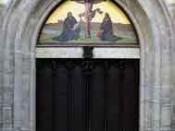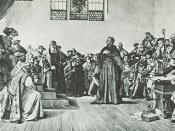Luther initiated the Protestant Reformation. The Protestant Reformation had the goal to separate from the Catholic Church. Luther had been enraged with the church's selling of Indulgences. Not only was the church misleading people about the authenticity of Indulgences but the funds from the sales were used to fund St. Peter's Basilica in Rome. Citizens would not have minded them so much if they had only benefited their local area, but instead it wasn't. Luther responded in both a revolutionary and conservative way to these social and political questions of the day.
As a revolutionary Luther responded to many of the church's lies and misleadings. In 1517 he published his 95 theses. These listed the 95 things he found wrong with the Catholic Church; from the sales of indulgences, to the many lies and misleadings. Then again, he made another revolutionary act when he nailed his 95 theses to the church in Wittenberg.
The Catholic Church felt that they were always right, and Luther, in nailing his theses to the church in Wittenberg, made a huge proclamation against the church.
At the Diet of Worms in a debate, he turned, for the first time, to the authority of scripture alone. He also questioned the church's infallibility. He was ordered to recant by Charles V, a very devout Catholic, but refused to do so, for it would be against scripture and against his own conscience. He was then excommunicated, and lived for one year in a supporter's castle while translating the New Testament of the Bible into German.
The way Luther reacted to the Peasant revolt reflected his views on being conservative. The peasants had been upset with the territorial princes' rule over traditional laws and beliefs. In 1524 they revolted violently. Luther believed their views were right,


Good essay
On the whole a good essay. Although this article wasn't exactly on the most interesting topic, I still enjoyed reading this piece of work because it was well-written and easy to read.
10 out of 10 people found this comment useful.